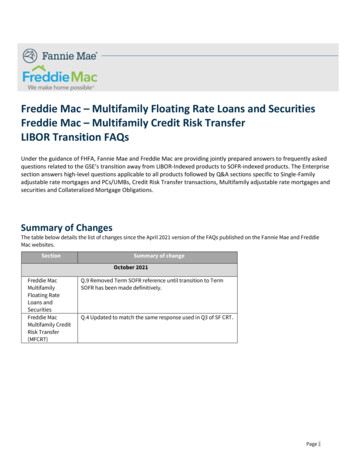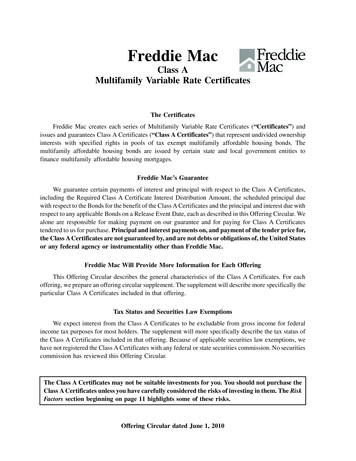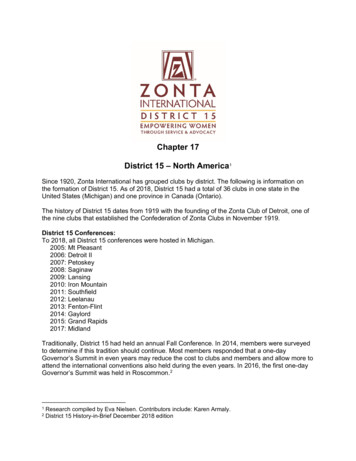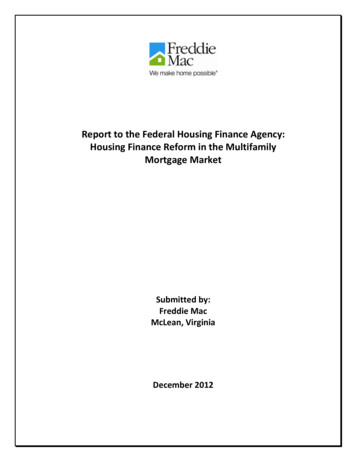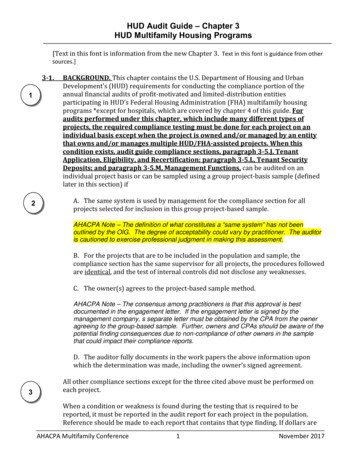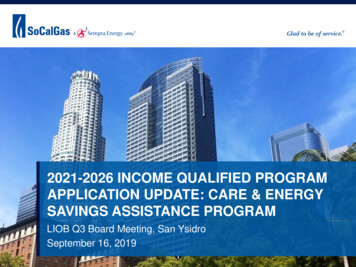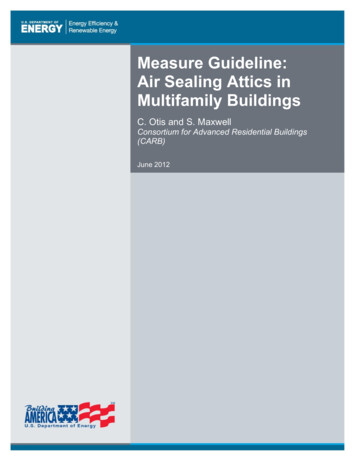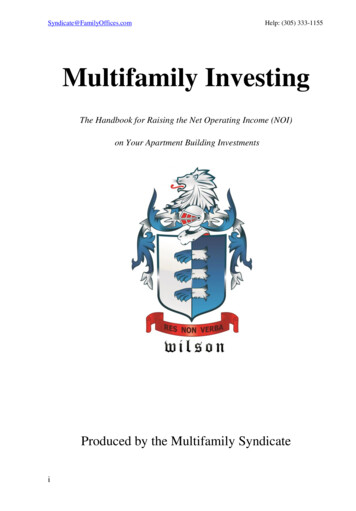
Transcription
Syndicate@FamilyOffices.comHelp: (305) 333-1155Multifamily InvestingThe Handbook for Raising the Net Operating Income (NOI)on Your Apartment Building InvestmentsProduced by the Multifamily Syndicatei
Syndicate@FamilyOffices.comiiHelp: (305) 333-1155
Syndicate@FamilyOffices.comHelp: (305) 333-1155Dedicated in memory to my friend Douglas MacLeaniiiVisit: http://FamilyOffices.com/Syndicate
Syndicate@FamilyOffices.comivHelp: (305) 333-1155
Syndicate@FamilyOffices.comHelp: (305) 333-1155Table of ContentsChapter 1: Overview Page 9Chapter 2: Investment Strategies Page 17Chapter 3: Deal Origination Page 31Chapter 4: Expense Reduction Checklist Page 45Chapter 5: Energy Saving Strategies Page 53Chapter 6: 30 Ways to Increase Revenue Page 59Chapter 7: Superior Debt Navigation Page 73Chapter 8: Future of Multifamily Investing Page 81vVisit: http://FamilyOffices.com/Syndicate
Syndicate@FamilyOffices.comviHelp: (305) 333-1155
Syndicate@FamilyOffices.comHelp: (305) 333-1155DisclosureThe contents of this book, including any videos presented herein, do notconstitute an investment recommendation. As such, this book does notcontain all information that a prospective investor may desire in evaluatingan investment strategy or individual investment.Each investor must rely on his or her own examination of an investmentstrategy or individual investment, including the merits and risks involved inmaking an investment decision. Prior to making an investment decision, aprospective investor should consult his or her own counsel, accountants, andother advisors to evaluate the merits of an investment strategy or individualinvestment. Additionally, any discussion of the past performance of anyinvestment strategy or individual investment should not be relied on as aguarantee of future performance, and no warranty of future performance isintended or implied.Please check with an attorney or compliance officer before taking any actionsmentioned in this book. Certain debt, equity, expense reduction, revenueadding, or other real estate investment details provided here may or may notbe possible or legal in your jurisdiction and ensuring you are acting withinthe bounds of the law within your area is your own responsibility. The ideasincluded here are to help bring fresh ways to increase NOI to apartmentbuildings investments but the interviewees, author, and companies associatedwith this publication cannot be held liable for any result or lack of resultsfrom taking action on anything taken from this publication or any referencedresources.viiVisit: http://FamilyOffices.com/Syndicate
Syndicate@FamilyOffices.comviiiHelp: (305) 333-1155
Syndicate@FamilyOffices.comHelp: (305) 333-1155Chapter 1: IntroductionThrough running our Multifamily Syndicate of 475 investment firms allfocused on investing in apartment buildings, we have found a wide variety ofinvestment strategies, philosophies, and ways to succeed in the marketplace.This book draws from the deals we examine, the debt deals we underwrite,the 300 financings our team has closed during our careers, and the 20families we represent worth over 100M apiece who almost all invest in realestate.The purpose of this book is to focus on what matters most when investing inapartment buildings (also known as multifamily investing) and boosting theNOI on the property. There are many resources on property management,valuation, definitions, history, statistics, market reports, etc. But at the endthe day, nothing moves the needle more and is a better investment of timethan investing in the processes and strategies that will boost the NOI on yourproperties and ultimately increase your returns. The goal of this 90-pagebook is to give you the #1 most thorough resource and exhaustive source ofideas for you to improve the returns on your multifamily investments.This book will start out with a very brief introduction of the multifamilyspace and then cover everything related to boosting NOI on a property, fromsuperior deal origination and debt structures to energy saving devices andnewfound revenue sources. The entire book is written to be consumed in lessthan 60 minutes. We made it this concise because we know your time is9 Capital Raising by Richard C. Wilson
Syndicate@FamilyOffices.comHelp: (305) 333-1155limited and valuable. We have included links to webinars, videos of expertpanel discussions, and other resources to help you dive deeper into the topicsdiscussed in this book.Investors have poured billions of dollars into the multifamily segment, butconsumers—from the millennial seeking an amenity-rich apartment to theAlzheimer patient in need of a memory-care facility—have proven that thereis still strong demand for new development. Investors and developers havemany reasons to like the multifamily segment.Perhaps chief among those reasons are the financial incentives. Multifamilydwellings provide owners with a diverse base of renters that provide monthlyincome without the same risk of losing a high percentage of that income as,say, a commercial building, where one tenant makes up a larger percentageof the net income than any individual multifamily occupant. Furthermore,the government and agency lenders (Fannie Mae, Freddie Mac, and FHA)have numerous programs that incentivize development, ownership, andrepositioning of multifamily properties, especially in senior housing andaffordable housing where the government wants to encourage developerswith cheap financing and other incentives.The asset class has proven stable and many investors over the last severalyears have experienced substantial appreciation along with steady income,making multifamily an essential part of many investors’ portfolios. Indeed,over the last couple decades, private equity firms and hedge funds havejoined the ranks of multifamily property owners, often making multi-milliondollar acquisitions.But most multifamily properties aren’t owned by hedge funds and alternativeinvestment firms. Most owners of apartment buildings and multi-unit10
Syndicate@FamilyOffices.comHelp: (305) 333-1155dwellings are more typical investors, from a local business owner looking todiversify with a twelve-plex to a high-net-worth family that have ownedseveral properties in the area for a generation or more. Many so-called“average investors” have been drawn to multifamily by the ability to obtainfinancing and the encouragement from financial gurus like those who havespoken at our real estate conferences, such as Grant Cardone and DavidLindahl.If you go into multifamily the right way, over the nextdecade it could be the best investment of your lifetime— and I put my money where my mouth is. I currentlyown almost 4,000 apartments and will soon haveover 5,000.-Grant Cardone, bestselling author, multifamily investor, and panelistat our Real Estate Investor Summit in 2017In the years since the financial crisis occurred and the housing bubble burst,many institutional investors and family offices rushed in to scoop upundervalued multifamily properties. The collapse of the U.S. housing marketleft many over-levered real estate investors facing debt payments that weretoo high and in many cases the banks or lenders took the buildings in lieu oflate or defaulted loan payments. Thousands of properties were sold fordistressed prices either by the bank or owners looking to cut bait and sell in adifficult real estate environment.Free Book: If this is the first time you are hearing about thefamily office investor concept please learn more by downloadinga free copy of our bestselling: http://FamilyOffices.com11Visit: http://FamilyOffices.com/Syndicate
Syndicate@FamilyOffices.comHelp: (305) 333-1155Private equity firms, family offices, and even hedge funds capitalized on theopportunity, funneling billions of dollars in private capital to buy cashflowing apartment complexes, condominiums, and commercial buildings. Aswe discuss at our many Family Office Deal Flow & Family Office RealEstate Investor Summits each year (http://FamilyOffices.com/Real), there arenumerous reasons that family offices and other institutional investors areattracted to this corner of the real estate market. Here are a few of thereasons:1) Cash-Flow: Family offices are buying multifamily real estate in largepart out of pursuit of cash flow. A tenanted real estate propertymeans that, assuming operating expenses are reasonable (includingdebt, importantly) and that you’ve selected a building at an attractiverate, you could see a profit in the first month. If you’ve ever rentedan apartment in NYC (as I have), you know that apartment buildingowners may go several years without making any improvements tothe property. Other, more active owners will make modestimprovements to the facilities and the units over time in order toincrease the NOI per unit and boost the overall value of the building.Consider, for example, if a building owner decides to add a secondbathroom to a 2-bedroom unit. That addition could increase the rentfor that unit because with separate bathrooms, a two-bedroomapartment becomes more attractive to two renters sharing theapartment (and combining their income to pay more rent than a singlerenter would). For family offices and other investors in multifamily,increasing the NOI is key and the many different ways that ownerscan do this is an important (and attractive) feature of multifamily12
Syndicate@FamilyOffices.comHelp: (305) 333-1155investments.2) Avoid Development: There are a number of family offices thatsuccessfully develop real estate from the ground-up (at our Junesummit, we had a representative of Donald Trump’s family officespeak about his boss’s well-known real estate endeavors, forexample). But for many family offices, the notion of sinking millionsof dollars into a real estate project that won’t return profits for severalyears isn’t as attractive as buying an asset that is leased/rented out andproducing cash now. By avoiding development-phase properties,these investors also may be able to avoid delays like building permits,contractor disputes, zoning issues, etc.3) Attractive Asset Class: One successful real estate investor whospoke at CapitalCon—a Family Office Club annual event featuringonly speakers who have raised 100M in their career—offered thefollowing explanation for why he moved from private equity tostrictly real estate investing: “In what other asset class are youincentivized to borrow money to buy real estate and then if youimprove an asset’s NOI by 105,000 in a 7% cap-rate environmentyou can increase the property’s value by 1.5 million?” If thatdoesn’t get you excited about multifamily, I don’t know what will.4) Financing: Today is, of course, a time of historically low interestrates which allows borrowers (both individuals and institutions) toenjoy reasonable financing costs when acquiring these properties.Multifamily buildings are typically viewed by lenders as relativelylow risk compared to other loans. Apartment buildings and condosgenerally produce cash to its owners (which goes to finance the debtpayments on the loans) and, in the event of a default, the lender has a13Visit: http://FamilyOffices.com/Syndicate
Syndicate@FamilyOffices.comHelp: (305) 333-1155reasonably liquid form of collateral that it can expect to sell to acompetitive market of buyers. Lenders also may have cheap access tocapital thanks to GSEs like Fannie and Freddie and governmentprograms that make it less risky to finance certain properties,especially those meeting the GSE requirements.5) Housing Trends: After peaking a little over a decade ago,America’s home ownership % has dramatically fallen in favor ofrentals. All that demand has created demand for more apartments andrentals for renters. While home prices suffered a severe blow andmany home owners are still underwater, rental prices continued toclimb, largely undeterred by an economic recession and a housingcollapse.6) Invest in What You Know: One investor on stage at a FamilyOffice Club Summit recently talked about investing in what youknow. It’s a philosophy by which many family offices abide andnone other than Warren Buffett has echoed the sentiment with hisCircle of Competence. For a number of wealthy families, owning realestate is intuitive. It doesn’t mean they made their wealth all throughreal estate necessarily, but it does mean that the families own a home(or several), or own apartment units, or feel comfortable buyingbuildings in their local market. At the end of the day, if it’s betweenbuying a black box hedge fund that the patriarch can’t comprehend oracquiring equity in the apartment building near his athletic club, he’sgoing to go with what he knows.14
Syndicate@FamilyOffices.comHelp: (305) 333-1155Here is a short webinarwe conducted onMultifamily investingrecently whichprovides an overviewof the space in caseyou are a potentialinvestor or new investor in the he next few chapters of this book will briefly cover typical investmentstrategies and deal origination and then quickly get into the chapters onexpense reduction, energy efficiency, and how to add new sources of revenueto your apartment community investments.15Visit: http://FamilyOffices.com/Syndicate
Syndicate@FamilyOffices.com16Help: (305) 333-1155
Syndicate@FamilyOffices.comHelp: (305) 333-1155Chapter 2: InvestmentStrategiesSpotting and recognizing opportunities is the trickiest part of real estate-what is working today might not work tomorrow and vice versa, so ourobjective is to be as forward-thinking as possible, enabling us to producegreat results for our investors.-Brian Burke, President and CEO of Praxis Capital and longtimemultifamily investorMany times, multifamily investors start where they can with lower quality Band C properties in the 5-25 unit or sometimes 50-100 unit range. Over time,however, most firms who have acquired 10 properties develop a honed inrefined strategy, with a unique strike zone from many others that builds onsynergies, and allows them to only acquire properties which they can producethe best returns for themselves and/or their investors. This chapter willbriefly review the most common strategies we see being used in themarketplace, but this list is not exhaustive and some firms will typically gowith one strategy but opportunistically keep their eyes open to other ways ofproducing returns.Strategy A – Re-Position: This strategy is going into a property that isgeneric and re-positioning it to cater to a specific demographic or tenant typethat is going to be the target demographic moving forward. It could justmean bringing the property a bit more upscale to cater more to the type of17Visit: http://FamilyOffices.com/Syndicate
Syndicate@FamilyOffices.comHelp: (305) 333-1155tenant that expects a certain level of quality, or it could be catering to seniors,students, executives, etc. One of our Multifamily Syndicate members, DaveOsborne of CRE USA, does this, on average spending 5k- 10k a door,which is the most common range we hear across all of our members. Manytimes that figure does not include upgrades to the exteriors such as paint,landscaping, roofing, parking lot, or clubhouse refreshing.This strategy has been successful as of late with buildings that lack thetype of amenities that many millennials and younger consumers want. Forexample, here in Miami, it has become standard for the Downtown, Brickell,and Coconut Grove buildings to offer a premium gym, outdoor pool(s), valetparking, and even spa services. In a relatively short amount of time you’llsee a building that was ordinary and rundown transformed into a millennialhotspot with a popular bar leasing the bottom floor and a bevvy of amenitiesto attract younger tenants with disposable income.One example of such a re-positioning deal that could also be described asa fix and flip due to the speed at which a buyer came to them was completedby Nizan Mosery of Cornerstone Investment Partners:“Cornerstone purchased a 224 unit complex in Houston 6miles south of the new ExxonMobil office complex. Wepurchased it for 6.7m and within 28 months we sold it at10.25m. Our investors made around 87% total cumulativereturn.we bought it at a great time. We brought in a top managementcompany that knew the market well and knew how to collect rents. Theywere very relevant in the due diligence process, retaining residents andchecking new prospects. We handled the deferred maintenance quickly18
Syndicate@FamilyOffices.comHelp: (305) 333-1155and gave our residents a place they could be proud to call their home. Themarket was just at the right point where we were able to ride the cycle upand enjoy fast appreciation.it’s all about the market timing, location andgreat management.”Strategy B – Fix & Flip: This strategy generally involves extensionrenovations to a property after acquisition and it is typically taking a C or Bproperty and trying to make it a B or A property so rents can be greatlyraised. Usually the property is let to settle to get it leased up at the higherrental rates and bring the rolling 12 months rent roll up to as little vacancy aspossible before selling. This lends itself, if there are not great delays frompermitting, to a 3-4 year holding time minimum and it may take 6-24 monthsto sell the asset, so it easily gets into a normal private equity fund-like 5-7year holding period.Strategy C – Aggregation: This strategy could involve anotherinvestment strategy as a first step to make the property more effective in itslocal market, but then importantly involves no real intent to then sell theproperty off. The goal here is to acquire good properties, clip decent %coupons each year, refinance perhaps every 10-30 years, and keep onacquiring more apartment buildings. Some of these investment firms willsell if they get an above market price offer on a property, but their intent is toacquire properties to hold for the very long-term or forever.Discussion Panel Audio Recording:One example of an aggregationstrategy is a group that has spoken at19Visit: http://FamilyOffices.com/Syndicate
Syndicate@FamilyOffices.comHelp: (305) 333-1155our events. They buy and hold student housing apartment buildings. If youare interested in the student housing space specifically, we had a discussionpanel on this exact area recently at one of our conferences. The audiorecording of that live discussion is available gy D – Partial or Full Development: Many multifamily groupshave construction experience and leverage to do ground-up construction ormajor renovations and expansions of smaller multifamily buildings. Sincemost people don’t want to get into this capital intensive of a business due tothe extra degree of risk, potentially longer investment horizon, andoperational risk that permits or construction won’t go as planned, it is a lesscrowded space. Many who succeed in the space look for what is referred toas infill spots—highly dense urban locations that are desirable to reside inwhich may have a plot of land available or which may be zoned for 150 unitswhile only having 25 or 50 units on the land currently. Typically highlyexperienced developers can promise better returns than those buying cashflowing properties on an IRR basis. The general consensus is also that if youinvest at the wrong time or a construction loan gets pulled by a bank due tobeing at a bad part in the economic cycle, you are more likely to lose moneyor lose all of your money in these types of investments.Strategy E – Conversion: Finally, we have the conversion strategy oftaking a hotel, senior living, or condo building and turning it into amultifamily. This is probably the least popular strategy because it requiresmany moving pieces and variables to line up just right. Due to permits, coderequirements which change drastically over time, permits, and the associatedcost with doing a conversion, we rarely hear of someone going after this20
Syndicate@FamilyOffices.comHelp: (305) 333-1155strategy exclusively. In fact, out of 475 multifamily independent sponsorsand investment firms we haven’t heard of a single one that solely focuses onthis strategy, yet each strategy listed above has firms which only stick to oneapproach on each investment they take.The conversion strategy may be the least straightforward, so we pulled afew case studies from interviewees for you to see examples of how thisworks:We acquired a property in the San Francisco BayArea, in a core East Bay market that was built in 2008in the thick of the real estate meltdown. The propertywas purpose-built as for-sale condominiums, but thecollapsing real estate market eliminated the developer's exit. Theproperty fell into bankruptcy and ultimately foreclosure and wassubsequently acquired by a multifamily operator who rented the units totenants and operated the property as conventional apartments. Seeing theopportunity here, we acquired the property for 15,750,000, resurrectedthe homeowner's association, and began selling individual condominiumunits, some to existing tenants, and the rest to homebuyers. Within twoyears, we sold all of the units for almost 150% of our acquisition pricewith very little capital improvements needed on the 9-year-old property.What was so different here was this was not a condominium conversion,which would require hefty construction to bring the units to condostandards and also carry entitlement risk from discretionary governmentalapprovals. This property was already built as condominiums, so this wasa simple arbitrage play where we sought to capture the delta between thebulk value and the individual value. Spotting and recognizing21Visit: http://FamilyOffices.com/Syndicate
Syndicate@FamilyOffices.comHelp: (305) 333-1155opportunities is the trickiest part of real estate—what is working todaymight not work tomorrow and vice versa, so our objective is to be asforward-thinking as possible, enabling us to produce great results for ourinvestors.-Brian Burke, Praxis CapitalOne case we purchased in bulk condos units in whichdevelopers had gone bust in 2010 in TriBeCa. Theunits could not be sold, as pricing at the time was verydifferent and these apartments possessed terriblelayouts and design. The closet space was a majorproblem, fixtures and design were lacking, and the concrete ceiling beamswere wavy, uneven, and unsightly. We were able to bring more value tothe units by creating much better closet space that HNW executives wouldneed for their families. We took the original closet and made it a herscloset and then built out separately an entire his closet. We were able todo this with the spaces as they were loft spaces with 1,000 sq ft masters.We also added high-end chandeliers and lighting fixtures while creatingencasements with sheetrock for the beams to make them symmetric andmore appealing. We were able to immediately bring in cash flow with ourlocal knowledge as we bank at Citi Private Bank and Citi Groupsheadquarters were two blocks away, allowing us to find executivetenants quickly.We also specifically added one unit on the top floor below the PH unit thatpossessed views of the Hudson River. The thought process was thatbecause the specific PH above this unit possessed NO views of the Hudson22
Syndicate@FamilyOffices.comHelp: (305) 333-1155River from any of the rooms due to terrible design and layout. It only hadtop outdoor space that had views. Now with our unit that possess views inevery room, we are able to achieve PH pricing for this unit by marketingthem as a combination, giving us a much higher exit then what could havebeen achieved with the unit on its own.- John Sorkvist, Quest Soho Equities, LLCThe strategy a firm employs will change how they look at a market,underwrite a deal, and manage a deal post-closing. For example, weinterviewed Brian Burke within our Multifamily Syndicate on what numbershe looks at first and most closely while investing and here was his response:The first numbers we look at are the number of units and the year theproperty was built. This might seem strange, but we have a specific“box” that we like our properties to fit into. If it is too old, too new, toosmall or too large, we simply skip it.From that point, there really is no “first”. We do a deep analysis onevery property that fits our box and scrutinize every line item of incomeand expense. We input all of this data into our analysis model andcompare the trailing 12-month income and expenses to the trailing threemonth income to form a base to our estimates of what the income andexpenses will be going forward. On the income side, we also layer in astudy on comparable rents at similar upgraded and non-upgradedproperties in the area. Once we have all of that data, we forecast targetrents, a ramp rate to get to the target, and build a forward-looking tenyear income statement. Ultimately, what we are aiming to achieve is to23Visit: http://FamilyOffices.com/Syndicate
Syndicate@FamilyOffices.comHelp: (305) 333-1155underwrite our exit, which means, "what price will we be able to sell forin three years, five years, or ten years." So to answer the first part of yourquestion, I suppose this all means that the first number we look at isultimately the last number we'll ever see—our exit price.Numbers that we ignore completely are the ones that don’t conform to ouroperating experience. For example, if the property is running 600 perunit per year in payroll, we’ll ignore that number because we know that itcosts twice that amount to effectively run a property. On second thought,we don’t “completely” ignore that number. We would use it as a clue thatthe property is being mismanaged and will most likely suffer fromdeferred maintenance.-Brian Burke, Praxis CapitalMany multifamily investment firms invest regionally or in just a fewselect cities mostly. Out of our 400 multifamily real estate relationships, weknow of only three who are truly national in scope and active nationally.Even then, though, those are strongest in one region or two to three cities.This is due, in part, to the challenges of sourcing and managing deals, and thedifference in tenant expectations and demands. It is also due to the scale ofthis industry—there are so many apartment buildings in just South Florida,San Diego, or New York that you could build a valuable portfolio whilestaying focused geographically. The advantage to that narrower scope is thatyou stick to what you know and keep your costs down by being able tomanage those closely associated properties more effectively if they are not allspread out.24
Syndicate@FamilyOffices.comHelp: (305) 333-1155Video: Here is arecording of adiscussion panel onmultifamilyinvesting whereyou can hear fivemultifamilyinvestors on stageat one of our 80 live conferences we have hosted discussing current trends,investment strategies, and how they approach the apartment buildingmarketplace: http://FamilyOffices.com/MultifamilyPanelClosely related to investment strategy is the investment structure throughwhich investments are being made by a firm. There are four typicalinvestment organizations that acquire multifamily buildings:1. Independent Sponsors: The most common type of multifamilyinvestment firm is the independent sponsor model where propertiesare purchased one-off by a nimble team who may or may not doproperty management on their investments, but who drive their valueup through one of the strategies mentioned earlier in this chapter. Inthis type of a model, assets can be held for a short or long period oftime and, while some independent sponsors are under pressure to sellafter a certain number of years, there is typically less pressure thanyou would find within a traditional investment fund.2. Funds: Investment funds are unique in that they often have the mostpressure to sell their assets within 7-10 years of acquisition. Manytimes, the managers of the fund will not be able to show a great IRR25Visit: http://FamilyOffices.com/Syndicate
Syndicate@FamilyOffices.comHelp: (305) 333-1155or earn their performance fees unless they sell before a certain timethreshold. This is one reason why there is always asset turnover. Asthese are professional investors, however, the properties they offloadoften have had the low-hanging fruit already plucked and they willtry to sell into the marketplace at lower cap rate valuations. Thismakes the prospect of buying from one of these professional fundsless appealing than a truly off-market deal where there remains a lotof untapped potential.3. REITS: Real Estate Investment Trusts (REITs) focused onapartment buildings are typically buying 1,000 unit portfolios orcommunities with 500 units in them as a large part of their interest.REITs are publicly traded and often have significant market capswhich allow for larger transactions. They have different investmentstrategies, but are typically holding their assets for 5-10 years at atime with an ability to sell again quickly or hold longer if they wouldlike to.Multifamily REITs have, of late, been pouring their billions ofdollars into new ground-up construction of residential housing—rather than paying top dollar to acquire a developed building orportfolio. Here’s an interesting recent article on this trend if you’reinterested in learning more about how REITs are deploying capital tothe multifamily family-reits-pourmoney-new-development4. Single Family Offices: A family office is a holistic wealthmanagement team for an ultra-wealthy individual typically worth 50M or 100M minimum and oftentimes 500M or more than 1billion. Usually these are buy and hold (or buy
- Grant Cardone, bestselling author, multifamily investor, and panelist at our Real Estate Investor Summit in 2017 In the years since the financial crisis occurred and the housing bubble burst, many institutional investors and family offices rushed in to scoop up undervalued multifamily properties. The collapse of the U.S. housing market
